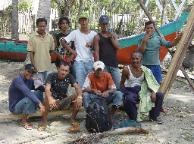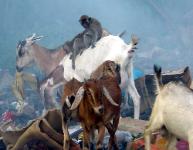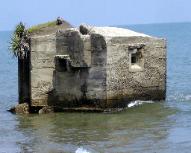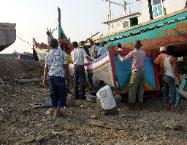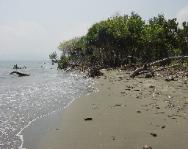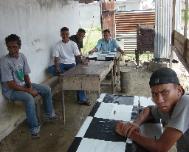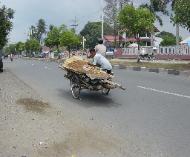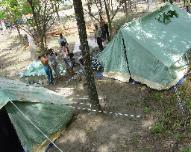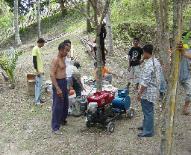
| 11 March 2005 - Eric In his press conference at the Pendopo on 11 March 2005, Indonesia’s Coordinating Minister of People’s Welfare, Alwi Shihab declared March 26th the end of relief and the beginning of reconstruction efforts in Aceh Province. He said that the government of Indonesia is deeply touched by the outpouring of generosity and contribution of all international community as well as Indonesian people. He extended his appreciation to not only UN agencies but also non- government organizations, local and foreign, which have assisted in alleviating the suffering of the people of Aceh. And there are certainly a good many top-notch people from many organizations doing a great job busting their ass everyday to get this place back decent. Indonesian agencies, local Acehnese groups, foreign international organizations public and private, governments military and metropolitan and all manner of religious sponsored groups have come together well with unique contributions according to their strengths. I congratulate their success in completing milestones on the plan to recovery. I have been fortunate to be able to cover many areas of Aceh in short time and get a general feel for the overall picture. Recently, I rode down the western coast to Lhok Nya to check out the destroyed cement factory and offer what little I know of concrete batch plants. I crossed several temporary single-lane Bailey Bridges of British military design. The original iron trusses sat twisted a ways upstream and half under water. The portable Bailey Bridge, which comes delivered by truck, is a series of truss members and pins assembled with a crane. Those bridges are good examples of a timely world response to the disaster and will obviously be valued tools in cleaning up and replacing four hundred kilometers of key coastal highway. Here’s to whoever built them. Of Indian Ocean regions affected by the tsunami, Aceh’s western coast near and facing the epicenter of the quake appears to have taken the hardest shot. From Aceh south uncountable thousands of ships, boats and craft of all sorts were swept inland and destroyed along with everything else. The earth along this stretch of coastline was deeply carved and according to locals moved inland an average of fifty meters. The topsoil was removed and the rest churned up leaving soil ranging from washed coarse sand near the coastal edge to thick layers of clayey silt in the flood-affected areas to down right fine sludgy goo at the high water mark. Bulldozers and track hoes are starting to make a dent in removing the debris along the more visible areas. Some vast areas have been cleaned, grubbed and bulldozed and knock you over with the stench of organic decomposition in the soil. At two and a half months since the tsunami, refugee camps are still everywhere but temporary barrack housing is springing up throughout villages across the province and slowly the people are creeping back one village at a time. The barracks are welcome relief but some of the 420,000 displaced persons who have lost everything fear having to live in barracks permanently. The villagers are pretty robust about rebuilding things. Yesterday I visited with members of Azhari’s village Lampulo, which used to be the heart of the provincial fish market. It is located in the city of Banda Aceh a few kilometers inland on Krueng Aceh river inlet. Some three hundred people are just getting back to the area and have been laboring intensely to remove debris and locate ditches, roads, wells and foundations. They use as sleeping and praying quarters a single large tent pitched upon the cleared broken foundation of their once beautiful mosque. Trucks of an international aid group delivers drinking water from GE’s water treatment plant on Lueng Bata to bladders draped over a slab of concrete. It often gets used up in between deliveries and so people continue to make water runs and use the filters I have delivered. The Katadyn filters were Aaron and Eddie’s brainstorm and have turned out to be a userful and practical way to provide drinking water for people during transitions from rescue to relief to reconstruction. Bringing as many as we could carry was also a good decision. Yoss, Rizal and I delivered a tent to Lampulo today with Pak Mahdi in his tiny Suzuki pickup. Lampulo’s boats are strewn about everywhere you look and many still have not moved since the tsunami. The repairable ones are being laid out and sorted in areas where buildings used to be. I saw a bunch of men cheerfully push a nine-meter boat up a dirt embankment over old tires and tsunami pieces and back into the water where it belongs. I saw one plastered into the second story of a big house. Abdul Hamid, Sea Commander for Lhok Krueng Aceh has just completed a summary of fishing boat devastation and will offer an industry reconstruction plan as part of Alwi Shihab’s master plan to be presented to the Indonesian cabinet in two weeks. Lampulo’s members have met to discuss their future. In Krueng Raya the joined gadings and lunas of ten boats await the next shipment of wood, which is said to be a few days away. Many transports near Lamteuba get military escort and with the demand on wood these days things are moving a little slowly. Meanwhile, the crew is shaping up the work site and just built a little shed to hold the generator and tools. Yesterday was the holiday of Nyepi where the entire island of Bali traditionally remains unlit for the night. The streets of Banda Aceh seemed quiet for being a Hindu holiday. Tonight there was a nice little quake that rocked us and left the building swaying for a few seconds afterward. It was enough to send most folks outside laughing and waving their arms and looking up and down for a while. I stood on the deck with my rope coiled and repel rig taught. Eric Lyman Banda Aceh, Sumatra |
Journal Entries
Journal Entries
